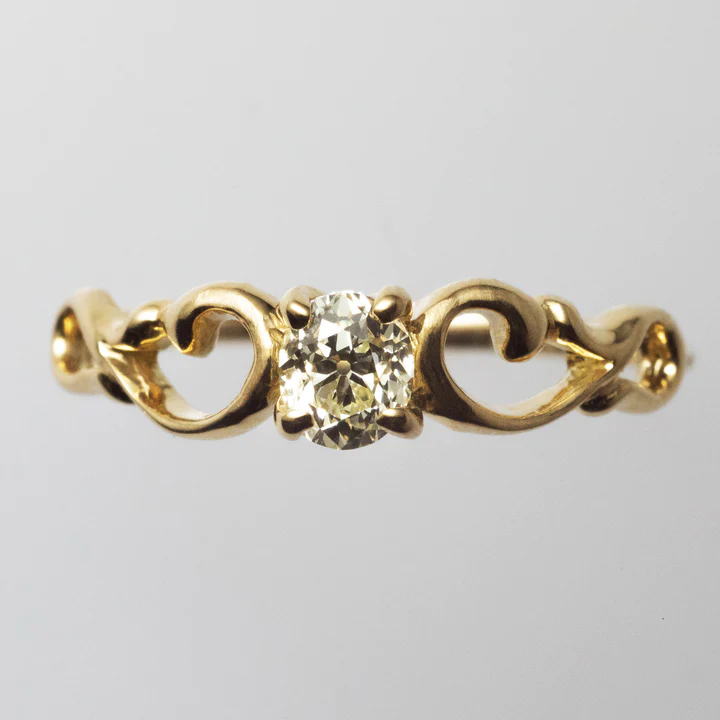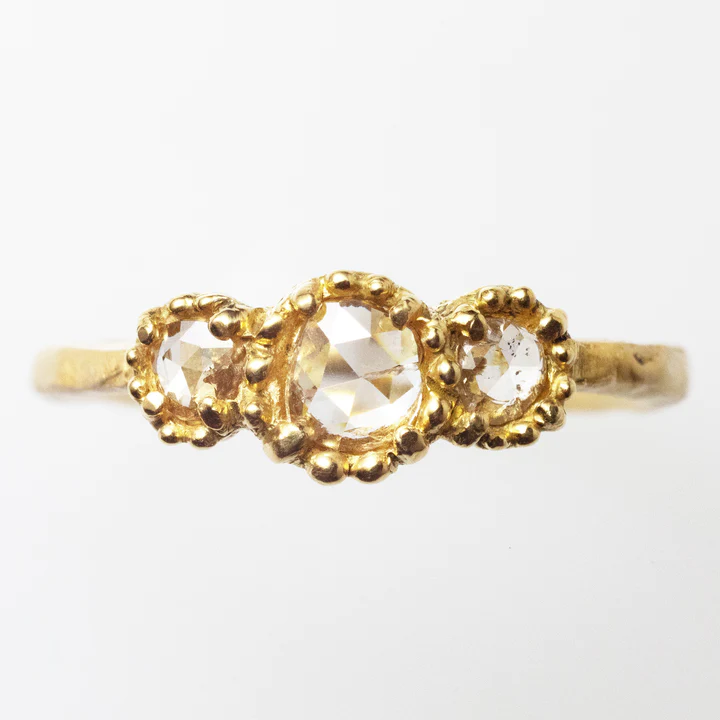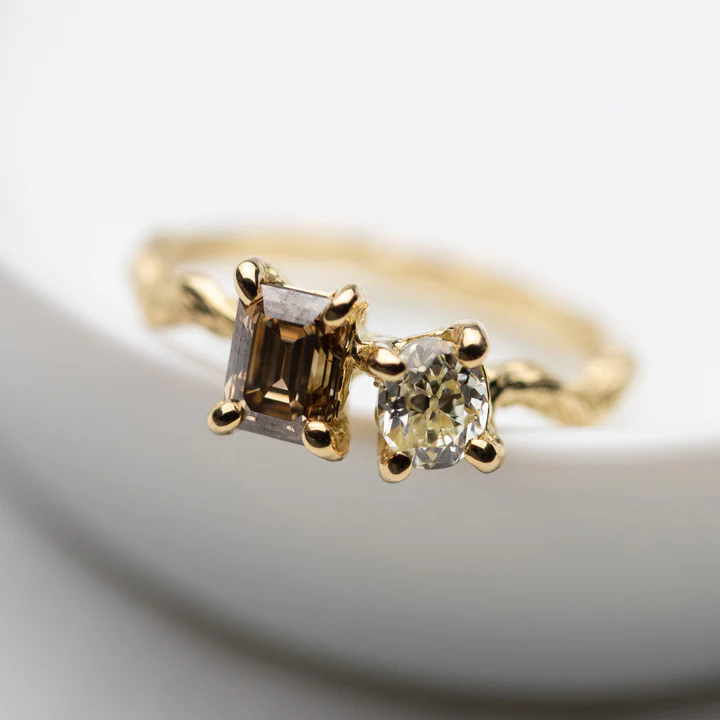DiamondVarious diamonds, each with its own story.
A ring filled with heartfelt meaning.
A gentle sparkle that brings color to everyday life.
Each person has their own way of cherishing a diamond.
The classic notion of an engagement ring as a round brilliant solitaire is just one option in a world of possibilities.
Whether it’s designed to fit seamlessly with a personal aesthetic and lifestyle or giving some meaning to the gem stone, the choice is yours.
Though we use the word "diamond" as if it’s one kind, but their diversity is truly astonishing.
From everyday jewelry to statement pieces for special outings, diamonds are not limited to engagement rings—they shine in countless moments.

The true value of a diamond is defined by the person who wears it.
While the 4Cs, created by the GIA, act as a benchmark for grading diamonds, they represent a strictly scientific viewpoint.
Sometimes, people are drawn to the unique character of a diamond’s inclusions or its subtle hues. When we search for diamonds for our clients, even when two stones are nearly identical by certification, one often captivates us in an unexplainable way.
Traditionally, diamonds with high clarity and a colorless appearance (as reflected in the 4Cs) have been valued as the most desirable and expensive. However, in recent years, there’s been a growing appreciation for diamonds with unique colors and inclusions, as they offer a rare and personal beauty.
Diamonds are no longer reserved solely for special occasions. Many designs today are perfect for everyday wear, adding a touch of brilliance to your daily life. Their unmatched hardness and the sparkle it produces are what make diamonds truly timeless. Learning about the many possibilities of diamonds transforms the process of choosing one into something truly special.
Ethical Diamonds
Ethical diamonds are gaining more recognition for their responsible sourcing practices. Canadian diamonds, as well as those once mined from the Argyle Mine—famous for its pink and high-quality colored diamonds before its closure in 2020—are known for adhering to strict environmental and labor standards and being conflict-free. At ilieva Jewelry, we source diamonds exclusively from trusted suppliers who comply with the Kimberley Process.
Antique diamonds are another fantastic choice for those who value sustainability, as they offer timeless beauty without additional impact on the environment.
We also feature lab-grown diamonds from Diamond Foundry, one of the few producers guaranteeing adherence to SDG principles.
Additionally, sapphires—often chosen as an alternative to diamonds for engagement rings—are increasingly being ethically mined and traded, offering yet another responsible option for those seeking conscious luxury.
The Diversity of Diamonds
When most people think of diamonds, they imagine a colorless, brilliantly sparkling stone cut in the classic round brilliant style.
In reality, the world of diamonds is far more diverse than it seems. Their variety can be classified into three main areas: cut, color, and clarity. These elements combine in countless ways, resulting in unique names and appearances for each diamond.
Cut
The cut is the only part of a diamond’s story where human craftsmanship comes into play, and it greatly influences the way the diamond looks and sparkles.
Not all diamonds are cut, however. Many raw, uncut diamonds with their natural, organic forms are admired as jewelry, showcasing the beauty created by nature alone.
For diamonds that are cut, the styles generally fall into two categories: those that enhance sparkle by reflecting light, and those that emphasize the diamond’s surface luster and clarity. Some cuts masterfully combine both, delivering a perfect blend of sparkle and transparency.




Color
Diamonds are often valued for their colorless transparency, a rarity in nature. According to the 4Cs grading system, lower grades in color reflect increasing yellow tones.
In reality, most natural diamonds have a yellowish or brownish hue. Those with vibrant and distinct colors are called “fancy color diamonds.”
The color of a diamond depends on its atomic makeup. For instance, nitrogen replacing carbon atoms creates yellow tones, while boron replacement results in a blue hue. Structural irregularities can lead to pink diamonds, and long-term radiation exposure can produce green ones.
Diamonds exist in nearly every imaginable color, but only certain shades—blue, red, pink, purple, violet, green, orange, and yellow—are graded by the GIA. Other colors, such as brown, black, gray, and white, are not subject to the same grading standards.
Additionally, some diamonds undergo artificial treatments, such as exposure to radiation or high-pressure techniques, to enhance or alter their color. Gemological testing can confirm if a diamond’s color is natural or artificially created.


Clearity
Rustic diamonds, a term used for diamonds without transparency or those blending clear and opaque areas—excluding black diamonds—have gained significant attention in recent years. Once overlooked, the natural and one-of-a-kind beauty of these diamonds has been increasingly recognized worldwide over the past 10 to 15 years.

Different way of calling diamonds
The word “diamond” refers to a type of mineral. Scientifically, it is defined as “a carbon allotrope where all four valence electrons are used in bonding.”
When people hear the word diamond, they each imagine something different. This is because diamonds have a wide range of unique characteristics. These differences are often recognized through the variety of names given to different types of diamonds.
Round Brilliant Cut
When most people think of diamonds, the image that often comes to mind is a round brilliant-cut, colorless diamond.
The brilliant cut, perfected around 1919, is designed to maximize a diamond's radiance. This cut allows light to enter from the top of the diamond, reflect fully within its facets, and exit again from the top in a dazzling display. As a result, it is particularly suited to diamonds with high clarity.
Due to its structure, the round brilliant cut has more depth than other cuts of the same carat weight, which makes its surface area appear smaller. However, this design ensures the diamond's brilliance is at its peak. Round brilliant-cut diamonds are evaluated based on the 4Cs and are among the most popular cuts, offering a wide variety of options.



Rough Diamonds
A rough diamond is a diamond in its natural state, just as it was discovered, without any cutting or polishing. All diamonds, of course, begin as rough stones. But even without refinement, these natural formations hold a distinctive allure.
Some rough diamonds take the shape of precise octahedrons or dodecahedrons, while others resemble meteorites or even grains of sugar that glimmer softly. Their appearances range from opaque with deep colors to completely colorless and clear.
On the surface of some rough diamonds, especially octahedral ones, you might find small triangular markings known as “trigons.” These marks are considered evidence of the diamond’s growth or traces of heat from magma deep within the earth. Flat triangular crystals, called “MACCLE,” are twin formations created when two crystals merge during their formation.
Rough diamonds highlight the extraordinary creativity of nature, offering a raw elegance that is both unrefined and profoundly beautiful.



Rustic Diamonds
Generally refer to diamonds with lower transparency or a higher amount of inclusions. These characteristics make them stand apart from the traditional expectations of perfection, offering something far more unique.
Due to their low transparency, they rarely display the full internal reflection seen in clear diamonds. Instead, they are often showcased in their raw form or enhanced by giving rosecut, which beautifully reflects light on the surface.
Though they may not conform to the 4C grading standards, these diamonds are unmistakably genuine, retaining the signature hardness and luster of all diamonds. For those looking to step away from convention, natural diamonds provide a rare opportunity to embrace individuality and natural artistry.



Diamonds with a mix of white and black inclusions are often referred to as “Salt and Pepper.”


Fancy Cut Diamonds
Fancy cut diamonds refer to all brilliant-cut diamonds that are not round brilliant cuts. These cuts are typically used for diamonds with high clarity.
These include shapes like oval, pear (also called teardrop), marquise, and cushion, all of which are designed to maximize internal light reflection. There are also cuts like princess and radiant that enhance brilliance and baguette or emerald cuts that emphasize transparency. Each shape not only offers a distinct form but also a unique way of sparkling.
Even within specific cuts like pear or marquise, there’s a spectrum of styles—from sharp and elongated designs to softer, plump contours, and everything in between.
Because fancy cuts are less commonly available than round brilliants, finding one with the ideal balance of shape, quality, and size often feels like an encounter with destiny, resulting in a diamond that’s truly unique.


Colored Diamonds
Colored diamonds, excluding black diamonds, refer to transparent diamonds with natural hues. Among them, red, green, purple, and orange are particularly rare, followed by blue and pink.
The most valuable colored diamonds are those with high clarity and intense coloration, often referred to as "fancy color diamonds." These diamonds can sometimes be more highly valued than their colorless counterparts.
The value of a colored diamond is determined by its clarity and the richness of its color. However, not all colors are natural. Some diamonds are artificially treated to enhance their hues, and the origin of the color can be confirmed through expert certification or appraisal.
In general, treated diamonds exhibit uniform color, while natural diamonds often display slight variations in tone. That said, among the most expensive natural diamonds, some have such flawless coloring that any irregularities are nearly invisible.



The Charm of Antique Diamonds
Antique diamonds refer to diamonds cut before the brilliant cut was perfected.
These diamonds are exceptionally rare, as many were recut into brilliant cuts over time. Popular styles include old mine cuts, old European cuts, and circular brilliant cuts, which mark the transition to the modern round brilliant cut.
Since these cuts predate the mathematical precision of today’s designs, each stone is uniquely crafted by hand. This often leads to variations, with gemological certifications sometimes listing them as “cushion modified” cuts. When contemporary artisans recreate these cuts, they are known as “modern antique diamonds.”
Antique diamonds have a softer, more romantic glow than the intense sparkle of modern brilliant cuts. They evoke the warmth and elegance of an era past, making you feel as though you’re holding a gem fit for a fairytale princess.


Rosecut Diamond
The rosecut diamond, dating back to the 1700s, was introduced long before diamonds were prized for their brilliance. Its name comes from its shape, reminiscent of a delicate rosebud.
The rosecut emits a soft, flickering light, making it particularly appealing to those who prefer a gentler, subtler glow instead of the usual sparkle associated with diamonds. Though it predates other antique cuts, the rosecut is still crafted today, setting it apart from those cuts.
It is also thought to have been crafted specifically to work with maccle crystals—naturally flat, triangular diamond formations.


Melee
The term "melee" originates from the French word for "tiny stones" and generally refers to diamonds smaller than 0.17 carats. However, it is often used as a collective term for all small diamonds. While 0.17 carats may not seem particularly small in Japan, some may feel uneasy calling such diamonds "melee."
Although this word is more of a technical term used by professionals, jewelers and artisans often refer to these stones by their exact carat weight or size for clarity. Melee diamonds are typically scattered delicately around a central stone to enhance its beauty or set closely together in a pavé design, creating a dazzling surface of stardust-like sparkle.
Lab-Grown Diamonds
With technological advancements, lab-grown diamonds have been gaining attention in the U.S. for the past few years and are now gradually becoming recognized in Japan. These diamonds are created in Lab (production facilities not experimental laboratories) under the same conditions as natural diamonds. They share nearly identical physical, chemical, and optical properties with mined diamonds, though they are distinguishable through gem identification processes.
While lab-grown diamonds are often seen as environmentally friendly, it is also true that many natural diamonds circulating domestically in Japan are recycled or reused.
At ileava jewelry, we exclusively offer lab-grown diamonds from Diamond Foundry, a rare provider in this industry with guaranteed traceability. During our sourcing process, we often encountered suppliers unwilling to disclose production details, raising concerns. Upon further investigation, we discovered that many lab-grown diamonds are produced in regions far from ethical and sustainable standards to reduce costs.
In contrast, every diamond from Diamond Foundry comes with certification proving it was produced in the United States. The company also guarantees a zero-carbon footprint by relying solely on hydroelectric power from the Colorado River. These lab-grown diamonds are not just about affordability but serve as a lifestyle choice for those seeking elegance, sustainability, and unique cuts.
Classifications by Diamond Settings and Design
Although it doesn’t refer to the diamond itself, the techniques or designs used to set them are often used to describe the style of a diamond.
Solitaires
When you think of a diamond ring, the image that likely comes to mind is a solitaire. A solitaire refers to a ring featuring a single diamond set at the center of the band.
With the spotlight on one stone, this style of ring is designed to highlight the natural beauty and brilliance of the diamond itself.
While solitaires are often associated with simplicity, “a single diamond = simple” does not mean the design must be minimal. At ileava jewelry, we mostly describe it as “a ring with one prominent stone.”


Eternity Rings
An eternity ring features diamonds set all the way around the band. When the diamonds are placed only halfway around, it’s known as a “half-eternity.”
While small round brilliant-cut diamonds are the most common choice, an eternity ring adorned with emerald cuts or slightly larger rosecut diamonds can add a unique and stunning touch.


Pavé
Pavé refers to a design where small diamonds are set closely together to create a surface of sparkle.
While pavé-ing on a flat surface offers a beautiful, uniform shine, setting diamonds on a slightly contoured surface allows light to reflect more naturally, creating a soft and gentle glow.

Halo
The term “halo” refers to a ring of light often seen around the sun or moon, symbolizing radiance and brilliance.
In jewelry, a halo design surrounds the center stone with a circle of small diamonds, creating the illusion of a larger and more prominent centerpiece.
The center stone doesn’t have to be a round brilliant cut—it can be a cushion cut, pear shape, rosecut, or even an antique diamond. By using slightly larger diamonds in the halo, the design can take on a unique and distinctive look.


Toi et Moi
“Toi et Moi,” meaning “you and me” in French, describes a design where two stones gently sit side by side, symbolizing partnership and connection.
The design offers endless possibilities—you can pair stones of the same size, mix larger and smaller stones, or experiment with different colors and shapes for a truly unique look.

Three Stone Ring
A three-stone design, as its name implies, showcases three stones as the centerpiece of the ring.
While the most common style highlights a larger center stone with two smaller stones placed symmetrically on either side, the design allows for flexibility—you can opt for stones of the same size or even play with asymmetry for a more personalized touch.


Clusters
Clusters are designs that bring together stones of varying sizes to create a striking, organic composition.
Typically, a larger stone sits at the center, encircled by smaller stones that are often larger than those seen in halo designs. However, clusters follow no rules—some resemble a “star cluster,” like the celestial Pleiades.
Maya affectionately calls cluster rings featuring colorful stones “salads,” for their playful mix of hues and shapes.

As you’ve seen, the world of diamonds is filled with endless variety and beauty. From their shapes to their cuts, from bold designs to soft, timeless forms, there is so much more to diamonds than meets the eye.
For those who may not have felt drawn to diamonds before, ileava jewelry offers a chance to rediscover their charm. Each diamond holds a story, and through its brilliance and form, it might just surprise you.
At ileava & co., we provide a wide selection of diamonds. We are also happy to help you find a diamond that matches your preferences—whether it’s budget, shape, color, or quality—ensuring you discover a stone that’s uniquely yours.







